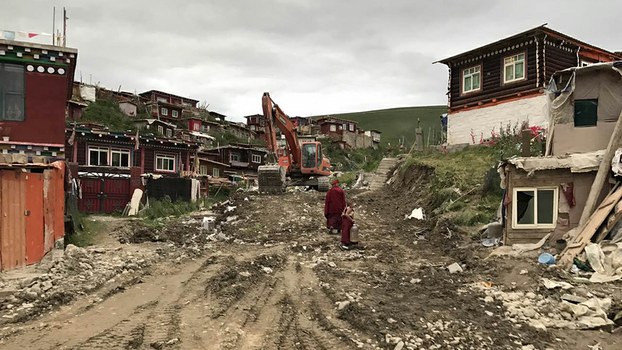Tibetet Segítő Társaság Sambhala Tibet Központ
Tibet Support Association Sambhala Tibet Center
székhely / telephely H-Budapest I. Attila út 123..
(00-36) 70 431 9343 (00-36)70 944 0260 (06-1)782 7721
sambhala@tibet.hu www.tibet.hu tibetpress.info
Facebook/Sambhala Tibet Központ Facebook/Tibett Segítő Társaság
MagnetBank/ 16200010-00110240
IBAN/HU94 16200010 00110240 00000000 SWIFT/HBWEHUHB
(1%) adószám/ 18061347-1-41
nyitva tartás/hétköznap 12.00-20.00 hétvégén előadás függő
» tibeti művészet» lapszemle.hu» thetibetpost.com» eastinfo.hu» rangzen.net» ChoegyalTenzin» tibet.net» phayul.com» DalaiLama.com» vilaghelyzete.blogspot.com» Videók» Linkek» TibetiHírek» Szerkesztőség
Demolition of Tibetan Residences Underway at Sichuan’s Yachen Gar Buddhist Center/ENG
2017. augusztus 15./RFA/TibetPress
eredeti cikk
Authorities in western China’s Sichuan province have begun demolishing 2,000 residences of Tibetan clergy at the Yachen Gar Buddhist Center and are set to expel an equal number of monks and nuns from the complex by the end of the year, according to Tibetan sources in the region.
“Chinese authorities ordered the demolition of 2,000 houses of monks and nuns at Yachen Buddhist Center … [by the end of] this year,” one source told RFA’s Tibetan Service recently, speaking on condition of anonymity.
“The demolition began on Aug. 8 and the work is said to be ongoing at Yachen Gar, while the same number of monks and nuns [2,000] are also to be expelled from the Buddhist center this year alone.”
Sources said that the monks and nuns had been ordered to tear down any homes built with wooden materials, and that demolition workers would be sent by the local authorities to raze any concrete structures in the area. One nun is said to have been injured in the demolition.
Yachen Gar, located in Kardze (in Chinese, Ganzi) prefecture’s Palyul (Baiyu) county and founded in 1985, until recently housed an estimated 10,000 monks, nuns, and lay practitioners devoted to scriptural study and meditation.
In April, sources told RFA that authorities had demolished at least 200 tents set up by Tibetan pilgrims visiting Yachen Gar to receive teachings and accumulate merit, citing difficulties posed by the encampments to the orderly management of the complex.
Following the beginning of the demolitions last week, a senior lama at Yachen Gar issued an appeal to the monks and nuns at the complex to “exercise patience and tolerance.”
“About 2,000 houses will be demolished this year and around same number of monks and nuns will be asked to leave the complex—this is an order from the powerful authorities and cannot be resisted, just as falling boulders from a mountain cannot be stopped,” the lama said.
“Most important is to remain humble and adhere to proper conduct, and things may get better. Also, it is important for all monks and nuns to take care of their health,” he added.
“The monks and nuns should exercise patience and tolerance under the stress of the demolitions and expulsion orders—this is crucial.”
Another Tibetan from the region, who also asked to remain unnamed, told RFA that the new order had placed “tremendous stress and hardship” on Yachen Gar’s Buddhist community.
“The demolition will cause a great amount of stress, as many monks and nuns will lack accommodations and be forced to leave,” the source said.
“Yachen monks and nuns are solely focused on Buddhist practice and not involved in any form of politics,” he added.
Restricted access
Authorities have been restricting access to the sprawling complex and areas nearby, with foreign visitors drawing particular scrutiny from police, sources told RFA in earlier reports.
In April, following the demolition of the pilgrim tents, sources told RFA that Chinese surveillance and other tightened security measures at Yachen Gar had become growing causes of concern for the center’s resident monks and nuns, and that it was increasingly difficult for news about the complex to reach the outside world.
They said that while Yachen Gar has internet service, residents had been reluctant to speak out about what was happening at the complex for fear of retaliation by authorities.
Restrictions on Yachen Gar and the better-known Larung Gar complex in Sichuan’s Serthar (Seda) county are part of “an unfolding political strategy” aimed at controlling the influence and growth of these important centers for Tibetan Buddhist study and practice, the Washington-based International Campaign for Tibet (ICT) said in a March 13 report, “Shadow of Dust Across the Sun.”
“[Both centers] have drawn thousands of Chinese practitioners to study Buddhist ethics and receive spiritual teaching since their establishment, and have bridged Tibetan and Chinese communities,” ICT said in its report.
At the end of June, a senior abbot at Larung Gar said that Chinese authorities had destroyed 4,725 monastic dwellings over the course of a year at the complex, with a total of more than 7,000 demolished since efforts to reduce the number of monks and nuns living at the sprawling center began in 2001.
The abbot said that more than 4,828 monks and nuns had also been expelled since 2016, with many forced back to their hometowns and deprived of opportunities to pursue religious studies.
Many thousands of Tibetans and Han Chinese once studied at Larung Gar Academy, which was founded in 1980 by the late religious teacher Khenpo Jigme Phuntsok and is one of the world’s largest and most important centers for the study of Tibetan Buddhism.
Reported by Kunsang Tenzin and Lhuboom for RFA’s Tibetan Service. Translated by Karma Dorjee. Written in English by Joshua Lipes.
